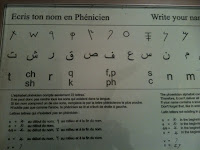I’ve just returned from a week in the Lebanon where I spent some time wandering around Byblos, which is on the coast, about 25 miles north of Beirut. Byblos is the Greek name for the ancient Phoenician city of Gebal, which in Arabic is Jubayl. It’s a pretty fishing village, a lovely place to walk around, with lots of old ruins, restaurants and cafes, and little tourist shops.
But Byblos is more than just a pretty tourist trap. It is also a UNESCO protected site for good reasons. Byblos is one of the oldest continuously inhabited cities in the world. People have lived here, uninterruptedly, since the Bronze Age some 8000 years ago.
Byblos had strong links with Ancient Egypt, and Phoenician traders exported Lebanese cedar wood to the Egyptians and to other ancient civilisations. The first writing paper, papyrus, was exported by its traders to the Aegean, and Byblos gave its name to the Bible, derived from Byblos, or the “papyrus book”.
It was where the Phoenician alphabet originated – the first widely used phonetic script in the world. It was spread by Phoenician merchants and its reach was huge; and because it was simple, it was adopted as the script of many different languages. It was also the first script that was accessible to all stratas of society, rather than remaining solely within the province of rulers and religious hierarchy. The roots of many languages, including, Middle Eastern, Greek, Latin, and European languages, can be traced back to the Phoenician writing system.
Here’s how to write your name in Phoenician – remember to write it from right to left, and please excuse my terrible photographs. I blame the camera of course...and blogger has just decided that it doesn't want me to upload pics from my comupter in a format that doesn't need require you to exercise your neck muscles...



The Jeita Grotto was another highlight of my week in Lebanon. It is one of the most wondrous places I have ever been. The Grotto is made up of two main series of crystallised caves froming the upper grotto and lower grotto that span over a hundred metres in height and eight kilometres in length. It is the shapes, colours, textures and size of the stalagmites and stalagtites, beauty and sheer enormity of the caves that combine to take your breath away. The caves are more beautiful than any temple or cathedral, more grandiose and sumptuous than any palace, and if you ever want to write a fantasy epic this is the place to go for inspiration. And if you just want to be completely blown away, this is definitely the place to go.










9 comments:
Interesting & atmospheric post and great photos despite blogger!
Thank you for the vicarious New Year sunshine, Savita.
Thanks, Penny. Despite blogger, and my three hours sleep, I somehow managed to get a few photos up!
beautifully descriptive sav. i wanna go back and visit now.
Hey TJ, if I get the chance, I will definitely go back to see the grotto - it's that awesome! Hope to see you there!
In a word, Wow!
Fascinating. I want to go there! We also went to a UNESCO site in the Seychelles in December, the only place where the coco de mer plant grows. I am interested to see that the Phoenician script has similarities to the symbols found on Paleolithic cave paintings worldwide, see: http://www.guardian.co.uk/science/2012/mar/11/cave-painting-symbols-language-evolution.
Joan, yes, wow indeed! The photos do no justice to the grotto at all.
David, thank you for the link, and for your post on Fire in the Forest - what an amazing project to be involved in! I feel I must add the Seychelles to my list of places to see and December seems to be a good time to go.
How interesting - I didn't know any of this! Thanks, Savita!
Savita, let me know if you are going to the Seychelles next December, we can arrange to meet there!
Post a Comment